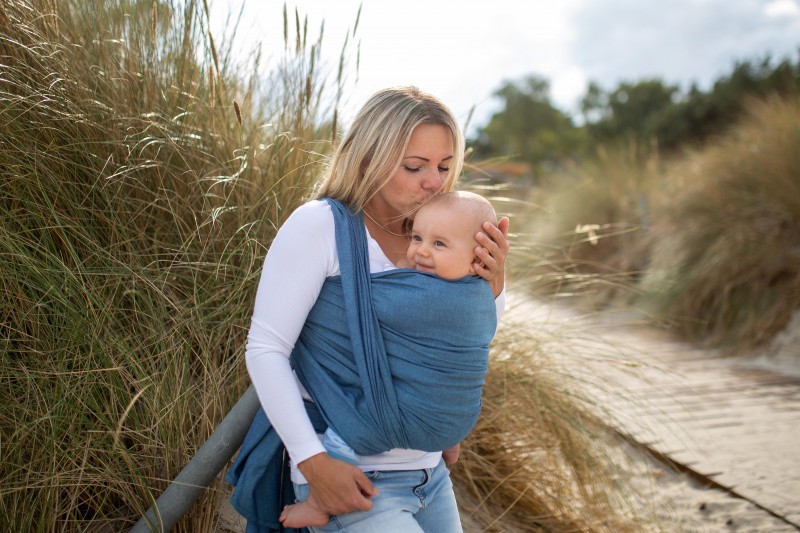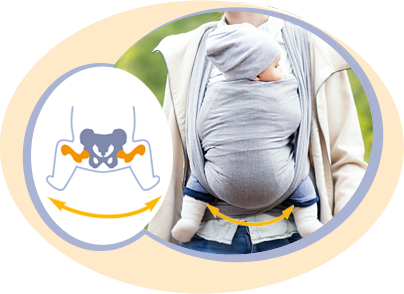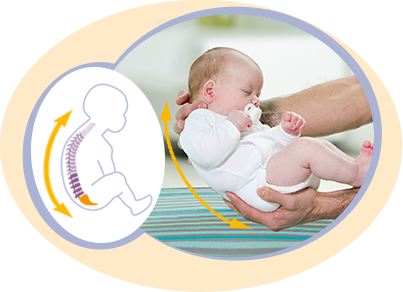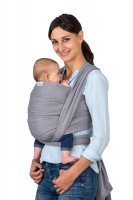Close. Secure. Safe – How to carry your baby correctly
Babies love to be carried – this is how it was millennia ago, and how it still is today. The irreplaceable physical proximity to the parents fulfils their basic need for security and therefore encourages self-confidence and independence.
Correct carrying helps to give your baby the optimum posture, and is therefore extremely important for physical development.
Just watch what happens when a baby is picked up: It automatically stretches its arms out and pulls its legs in - the perfect position for being carried on the hip.
Your baby’s body in the womb
Babies come into the world with a rounded back. During their development in the womb, the curved spine, which is known as total kyphosis in medical terms, is the perfect position.
The baby’s legs are also extremely bent. That which would look like a dislocated hip on an adult is actually extremely important for the hip joint socket development of your baby.
This is how the body of your baby develops after birth
Development of the hip joint and the spinal column after birth
The hip joints of the newborn have to cope with slow stretching of its skeleton (predominantly consisting of cartilage) until the end of the first year of life.
The spinal column slowly stretches. A delicate process which requires an entire year, and is not completed until the young child can stand up and start to walk.
How to support your baby during the development of its body:
In order to support the stabilization of the hip sockets in the best possible way, the hip joint must be bent as often as possible and not stretched from the outside. It is better to carry your child than to push it in a pram in front of you. Make sure that its back is rounded and its legs are flexed at the knee. (The so-called frog position)
Our TÜV-tested carrier systems fulfil all of these strict requirements!
Safe and secure – the only way to carry your baby correctly
The baby should be facing you: Only then is the baby’s back really rounded, making it feel secure.
Never put your baby in a carrier facing forwards. The baby will be engulfed with more new impressions than it can take in. The spinal column will not be able to adopt the desired, curved posture if this is the case.
The Amazonas slings and baby carriers are perfectly coordinated with the needs of the little ones with rounded backs. At the same time, they provide adults with complete security, a high degree of carrying comfort and complete suitability for everyday life.
The more often you keep your baby close, the more secure it will feel and it can become more self-confident and independent. It is easier to become curious from a secure position on mum or dad’s chest. Strange things are not perceived as a threat, but something exciting and new!
Close. Secure. Safe – How to carry your baby correctly
Babies love to be carried – this is how it was millennia ago, and how it still is today. The irreplaceable physical proximity to the parents fulfils their basic need for security and therefore encourages self-confidence and independence.
Correct carrying helps to give your baby the optimum posture, and is therefore extremely important for physical development.
Just watch what happens when a baby is picked up: It automatically stretches its arms out and pulls its legs in - the perfect position for being carried on the hip.
Your baby’s body in the womb
Babies come into the world with a rounded back. During their development in the womb, the curved spine, which is known as total kyphosis in medical terms, is the perfect position.
The baby’s legs are also extremely bent. That which would look like a dislocated hip on an adult is actually extremely important for the hip joint socket development of your baby.
This is how the body of your baby develops after birth
Development of the hip joint and the spinal column after birth
The hip joints of the newborn have to cope with slow stretching of its skeleton (predominantly consisting of cartilage) until the end of the first year of life.
The spinal column slowly stretches. A delicate process which requires an entire year, and is not completed until the young child can stand up and start to walk.
How to support your baby during the development of its body:
In order to support the stabilization of the hip sockets in the best possible way, the hip joint must be bent as often as possible and not stretched from the outside. It is better to carry your child than to push it in a pram in front of you. Make sure that its back is rounded and its legs are flexed at the knee. (The so-called frog position)
Our TÜV-tested carrier systems fulfil all of these strict requirements!
Safe and secure – the only way to carry your baby correctly
The baby should be facing you: Only then is the baby’s back really rounded, making it feel secure.
Never put your baby in a carrier facing forwards. The baby will be engulfed with more new impressions than it can take in. The spinal column will not be able to adopt the desired, curved posture if this is the case.
The Amazonas slings and baby carriers are perfectly coordinated with the needs of the little ones with rounded backs. At the same time, they provide adults with complete security, a high degree of carrying comfort and complete suitability for everyday life.
The more often you keep your baby close, the more secure it will feel and it can become more self-confident and independent. It is easier to become curious from a secure position on mum or dad’s chest. Strange things are not perceived as a threat, but something exciting and new!

CORRECT CARRYING POSITION





